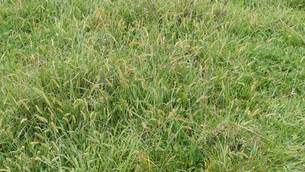Lesser canary grass
Phalaris minor
Lesser canary grass (Phalaris minor) is originally from the Mediterranean and is now a common, annual grass weed of winter planted cereal crops. Seeds germinate throughout the year with the leaves being non-hairy, rough and long, tapering to a fine point. The ligule is long and finely serrated, auricles are absent. When in ear the short, stubby panicle (1.5 - 6 cm x 1.2 – 2.2 cm) is quite distinct and makes a good identification feature.


Related Pests

Wild Oats
Avena fatua
Wild Oats (Avena fatua) Wild oats are a common and very damaging weed that can occur in many crops. Capable of germinating at any time of year, they will just as successfully grow and compete in winter cereals as in a spring planted crop like peas. Left uncontrolled wild oats will quickly grow into large, multi-tillered, competitive grass weeds. Due to their competitive nature very few plants per square metre are needed before it becomes economic to control them.
Depending upon the crop controlling 5-10 wild oats per square meter will result in an economic response. Wild oats also produce a large number of long-lived seeds, often as many as 150 per panicle with many panicles per plant. Wild oat seeds can remain viable in the soil for several years and the common saying “one year’s seeding, 7 years weeding” stands very true for wild oats. Wild oats can be successfully controlled with selective herbicides such as Puma S. However, if numbers are low hand rogueing should be undertaken if possible.
Depending upon the crop controlling 5-10 wild oats per square meter will result in an economic response. Wild oats also produce a large number of long-lived seeds, often as many as 150 per panicle with many panicles per plant. Wild oat seeds can remain viable in the soil for several years and the common saying “one year’s seeding, 7 years weeding” stands very true for wild oats. Wild oats can be successfully controlled with selective herbicides such as Puma S. However, if numbers are low hand rogueing should be undertaken if possible.

Yellow Bristle Grass
Setaria pumila
Yellow bristle grass (Setaria pumila) or YBG is one of a number of related species found in New Zealand and is widespread across parts of the North Island. It is a particular problem when it infests pasture as over time it out competes and replaces more productive species. YBG germinates in late spring as temperatures rise and grows quickly setting a large number of seeds from December onwards. Look for young plants in “gaps” in pasture. They have light green leaves with red bases and an upright habit. The seedhead is cylindrical, up to 10 cm long and yellowish in colour due to the bristles associated with each spikelet.

Annual Poa
Poa annua
Annual poa (Poa annua), also known as annual meadow grass, is a fast growing annual grass found throughout New Zealand in a wide range of crops. While individual plants tend to be small, populations of this grass weed tend to be large and they then compete for light, nutrients and water. Poa annua is best identified by the boat shaped tips to its leaves and the two parallel veins (often referred to as tramlines) that can be seen if the leaf blade is bent backwards. Germination takes place throughout the year and is set very quickly meaning populations soon increase.

Ryegrass - Perennial
Lolium perenne
Perennial ryegrass (Lolium perenne) is an important cultivated grass species which becomes a very competitive weed when growing in cultivated crops. Though it is a perennial species it will still produce seed in the first year of growth. Generally germinating at the same time as the crop it grows quickly and competes aggressively for space, light, nutrients and water. Uncontrolled perennial ryegrass will significantly reduce yields. To identify look for young plants between the crop rows, young plants are upright and the leaves have prominent veins. As plants get bigger the leaves are shiny underneath and these stand out, especially on breezy days. Later, when in ear look at the seedhead as ryegrasses have one edge of the seed against the axis which means the flat side of the seed is visible.





